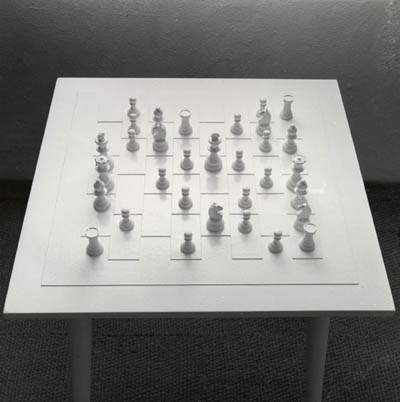
Exhibition Committee Presents:
![]()

Exhibition Committee Presents:

Art Exhibition "Into the Atomic Sunshine - Post-War Art under Japanese Peace Constitution Article 9h
Curator: Shinya Watanabe
Venue: Puffin Room (SOHO, New York)
435 Broome St
New York,
NY 10013
Time: Saturday, January 12, 2008 - Sunday, February 10, 2008
Opening Reception: Saturday, January 12th, 2008 6-8PM
Exhibiting Artists (Alphabetical Order):
Vanessa Albury
Allora Calzadilla
Kota Ezawa
Eric van Hove
Yutaka Matsuzawa
Yasumasa Morimura
Nobuyuki Ohura
Yoko Ono
Motoyuki Shitamichi
Yuken Teruya
Yukinori Yanagi
Special Event:
Saturday, Jan 19, 5PM- (Free)
Documentary Film Screening "White Light, Black Rain"
Steven Okazaki on the Atomic Bombing of Hiroshima and Nagasaki
+ Butoh Performance by Vangeline Theater Co.
Friday, Jan 25, 7PM-
Acoustic Live Music Performance
Miho Hatori + Special Guest
Concept of the Exhibition:
The Constitution of Japan was essentially written by US army officials from the General Headquarters (GHQ) in 1947. Parts of "Article 9", known as the peace constitution, renounces war and possession of potentially belligerent forces as the sovereign rights of the nation.
ARTICLE 9. Aspiring sincerely to an international peace based on justice and order, the Japanese people forever renounce war as a sovereign right of the nation and the threat or use of force as means of settling international disputes. In order to accomplish the aim of the preceding paragraph, land, sea, and air forces, as well as other war potential, will never be maintained. The right of belligerency of the state will not be recognized.
This very unique provision in the peace clause of the Constitution, which is unlike any seen in other parts of the world, reflects the idealism of the American New Dealers. This new Constitution was well-received by the Japanese people who experienced the bitterness of war, and it has not been altered for 60 years to this day. But now, faced with political instability in Asia and uprising nationalism, its very existence is being questioned.
The art exhibition "Into the Atomic Sunshine - Post-War Art under Japanese Peace Constitution Article 9", in a climate where the Constitution is faced with the possibility of it being revised, attempts to raise issues and awareness of the influence of the peace Constitution which played an important role in shaping post-war Japan and its influence on the Japanese people, and the reaction of post-war Japanese art.
Article 9 was greatly influential in helping Japan recover from war and helping to reshape the country. Through this article Japan avoided direct confrontation with other countries for more than 60 years. Although Article 9 has kept Japan from direct involvement in the war, its indirect involvement in wars has given Article 9 a twisted status quo. This unique situation has given artists the opportunity to discover a theme to tackle and express in their works. Numerous artists tried to deal with the issues such as post-war problems and identity problems, and these works are also related to the issue of Article 9 and world peace.
The exhibition title gAtomic Sunshineh was a nickname given to the conference that created the new Constitution of Japan, which was held by General Courtney Whitney of GHQ, Shigeru Yoshida (Prime Minister of Japan from 1947), Jiro Shirasu (translator) and Jyoji Matsumoto, the minister of Department of State who was in charge of creating the new Japanese Constitution, on February 13, 1946. General Whitney turned down Matsumoto's conservative Constitution scheme, and explained that the GHQfs version of the Japanese Constitution scheme was a definitive plan which embodied Japanfs current needs for principles, and that it was already approved by General MacArthur, the Supreme Commander of GHQ. Then the American group came down to the garden of the American officialfs residence and gave the Japanese group the time to read out the English version. When Jiro Shirasu, who was fluent in English, came out to the garden and joined the American group, Whitney said to Shirasu, "We have been enjoying your atomic sunshine."
This comment by General Whitney has made it clear to the Japanese who was the winner and loser of the war, and remarked that accepting the provisions stipulated in the GHQ draft will be the best way to keep the Emperor gsecureh, and if the Japanese government does not accept this plan, then General MacArthur is ready to propose this plan directly to the Japanese people. This conference to create the new Constitution later came to be called the "Atomic Sunshine Conference." Based on this GHQ plan, Japanese cabinet created the amendment plan, and it was proclaimed as new Japanese Constitution on November 3rd, 1946.
Aim of the Exhibition
Despite the uniqueness of Article 9, its very existence is surprisingly not well-known in other countries. Through this exhibition, not only will the post-war Japanese art be introduced, but the Article 9 of the Japanese Constitution will also be introduced to the audience in New York. The exhibition will investigate the historic significance and importance of how Article 9 was developed and how because of this, there was no blood shed from direct confrontation for 60 years after the war.
Curatorial Statement:
The Breakaway from the
Century of War@-@Article 9 as the Overcoming of European Modernism
by Shinya Watanabe
Exhibition Catalogue is now on sale
The exhibition sponsored by The Kao Foundation for Arts and Sciences, Asahi Newspaper Cultural Foundation and the Puffin Foundation.
Media Partner: ART iT, GENERATION TIMES
Suport: Daneyal Mahmood Gallery